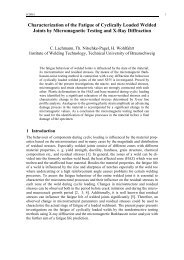nondestructive characterization of fatigue processes in cyclically ...
nondestructive characterization of fatigue processes in cyclically ...
nondestructive characterization of fatigue processes in cyclically ...
You also want an ePaper? Increase the reach of your titles
YUMPU automatically turns print PDFs into web optimized ePapers that Google loves.
2 nd International Workshop on Structural Health Monitor<strong>in</strong>g, Stanford University, 1999 6<br />
The analys<strong>in</strong>g frequency <strong>of</strong> the evaluat<strong>in</strong>g unit <strong>in</strong> the 3MA-system directly <strong>in</strong>fluences<br />
the depth to where the micromagnetic signals can be detected, the so-called<br />
<strong>in</strong>teraction depth. The excitation frequency <strong>of</strong> the power supply could be varied<br />
between 1 and 160 Hz and also has to be adapted to the maximum field strength and<br />
the material properties. From former parameter studies, an excitation frequency <strong>of</strong><br />
100 Hz and an analys<strong>in</strong>g frequency <strong>of</strong> 0.4 MHz was found to be at an optimum<br />
lead<strong>in</strong>g to a <strong>in</strong>teraction depth <strong>of</strong> ≈10 µm, which is similar to the penetration depth <strong>of</strong><br />
the X-rays used <strong>in</strong> the residual stress measurements.<br />
The commercial 3MA-test<strong>in</strong>g system used here is shown <strong>in</strong> Fig. 7 The raw data<br />
from the 3MA device could be transferred <strong>in</strong>to a computer for further data evaluation.<br />
Us<strong>in</strong>g a specially designed s<strong>of</strong>tware, the shape <strong>of</strong> the Barkhausen noise curve<br />
and the time signal <strong>of</strong> the tangential field strength could be analysed to derive further<br />
parameters [1, 10, 11].<br />
3 SIMULATION OF THE DEFORMATION BEHAVIOUR OF<br />
THE WELDED JOINT<br />
Depend<strong>in</strong>g on the load stress, <strong>of</strong>ten the greatest magnitude <strong>of</strong> local plastic derformations<br />
and correspond<strong>in</strong>g residual stress relaxation <strong>in</strong> a welded jo<strong>in</strong>t can be detected<br />
after the first load cycle and thus determ<strong>in</strong>es the further <strong>fatigue</strong> process to a<br />
great extent. For this reason, it is essential to <strong>in</strong>vestigate this static load step for an<br />
assessment <strong>of</strong> the <strong>fatigue</strong> behaviour. Fig. 8 shows the calculated distribution <strong>of</strong> the<br />
total residual stra<strong>in</strong>s after load<strong>in</strong>g <strong>in</strong>clud<strong>in</strong>g the elastic stra<strong>in</strong>s result<strong>in</strong>g from residual<br />
stresses at the surface <strong>of</strong> the weld for different maximum nom<strong>in</strong>al load<strong>in</strong>g stresses.<br />
Accord<strong>in</strong>g to the material properties (see Fig. 2 and 3), the hard weld bead <strong>of</strong> the<br />
f<strong>in</strong>al pass exhibits very small plastic deformations <strong>in</strong> comparison to the s<strong>of</strong>t base<br />
material. At the weld toe, the geometrical notch at the transition from weld material<br />
to HAZ leads to a local stress concentration and thus high local (plastic) stra<strong>in</strong>s. A<br />
similar effect can be observed at the transition zone from HAZ to base material. The<br />
400 MPa<br />
500 MPa<br />
550 MPa<br />
400 MPa<br />
500 MPa<br />
550 MPa<br />
Base Mat. HAZ Weld<br />
Base Mat. HAZ Weld<br />
Fig. 8 Calculated stra<strong>in</strong>s (elastic and plastic) after different load<strong>in</strong>g stresses across the surface <strong>of</strong> the<br />
weld FEM-model (left: f<strong>in</strong>al pass, right: cap pass)



